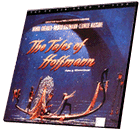Director:
Michael Powell and Emeric Pressburger
CLV: $99.95 - 2 discs, catalog # CC1300L
VHS: $39.95 from Home Vision Cinema
Of the 18 movies made by the filmmaking team of Michael Powell and Emeric
Pressburger, none was as personally and artistically fulfilling as
The Tales of Hoffmann.
This dazzling screen adaptation of the Offenbach opera
-- a visual, sonic, and sensual delight
-- marked the capstone of their work together,
and the end of an era in British cinema.
The Tales of Hoffmann,
presented here for the first time in America in its complete
127-minute running time, is a miraculous convergence of talents from the
worlds of cinema, music, and the ballet.
Powell and Pressburger were two of the most celebrated filmmakers in the
world, responsible through their production company, The Archers, for
The Red Shoes, Black Narcissus, Stairway to Heaven,
I Know Where I'm Going!, A Canterbury Tale, and
The Life and Death of Colonel Blimp.
It was Sir Thomas Beecham, who had conducted "The Red Shoes Ballet" in
The Red Shoes, who first suggested to Powell and Pressburger that
they do an operatic film. After some discussion, they agreed that
Jacques Offenbach's 1881 opera The Tales of Hoffmann,
with its unusual narrative structure and fantastic plotline, afforded the
best opportunity for Powell to realize his
long-cherished goal, of "composing" a film to music.
The next step was
for The Archers to convince Sir Alexander Korda, the head of London Films
which was financing their films, that Hoffmann would work as a movie.
Korda was persuaded to do the film based on Powell's promise to sign
Moira Shearer, the star of The Red Shoes.
Powell and Beecham determined early on to adapt Hoffmann to film
using a pre-recorded music track by Beecham. The conductor would make the
recording of the opera -- in a brand new translation into English -- with
his own Royal Philharmonic Orchestra and the Sadler's Wells Chorus,
and recruit the best singers for each part.
Then, The Archers would film the opera in an adaptation with newly added
ballet parts, danced, acted, and mimed to the pre-recorded music
tracks provided by Beecham.
Beecham's singers included New York City Opera
stars Robert Rounseville and Ann Ayars, who also acted their respective
parts of Hoffmann and Antonia on screen;
Margherita Grandi as Giulietta, singing the celebrated "Barcarolle"
from Act II; Dorothy Bond as the doomed mechanical doll
Olympia; and Bruce Dargavel in a joyously sinister performance as the multiple
villains in the various tales that made up the opera.
For their dancers, Powell and Pressburger returned to the cast that
they'd assembled for The Red Shoes three years earlier:
dancer-choreographer Robert Helpmann, who would
play and dance the parts of all four of the opera's villains;
Leonide Massine, already a living legend of 20th century ballet,
playing the various knaves and fools on the fringes of Helpmann's
machinations;
Ludmilla Tcherina, the celebrated prima ballerina of the Monte Carlo
and Paris Ballets, as the sensuous, predatory courtesan Giulietta;
and Moira Shearer, the star of The Red Shoes, as Olympia
and the lovely Stella, the unrequited object of Hoffmann's
affections.
In order to ensure Shearer's participation in the movie, and, by
extension, Korda's backing for the project, Powell and Pressburger engaged
the services of choreographer Frederick Ashton, one of the leading figures
in
the dance world. To Powell's delight and surprise, Ashton agreed not only
to
choreograph the ballet adaptation of the opera, but also to dance two of
the roles himself.
Hoffmann, in effect, was created as a "silent" film, shot in
purely visual terms, with all of its images based on The Archers' impressions
of the music. The result is one of the purest visual fantasies ever put
on
film, a phantasmagoric journey into a world of sensual delights and
transcendent decadence.
The Tales of Hoffmann found an audience far wider than expected,
despite Korda's misgivings about the movie's running time and his
decision to cut 14 minutes out of the film for its American release.
Ironically, The Tales of Hoffmann was to be one of the last major
films ever released by Korda, as well as the final important film from
The Archers.
Over the 41 years since, the movie's reputation has grown (even on the
strength of the truncated American version), influencing such filmmakers
as Martin Scorsese and George Romero, while terrifying and seducing three
generations of filmgoers.
--
BRUCE EDER
Credits
Written, Produced and Directed by:
Michael Powell and Emeric Pressburger
Produced by: The Archers for London Film Productions
Screenplay: Denis Arundell
Translated from the libretto by: Julies Barbier
Music: Jacques Offenbach
Music Director: Sir Thomas Beecham
Choreography: Sir Frederick Ashton
Photography: Christopher Callis
Camera Operator: Freddie Francis
Production Design: Hein Heckroth
Art Director: Arthur Lawson
Editor: Reginald Mills
Associate Producer: George Busby
Assistant Director: Sydney Streeter
Scenic Artist: E. Lindegaard
Transfer
The Tales of Hoffmann is presented in its original aspect ratio
of 1.33:1. This transfer was mastered from
a 35mm composite print made from the newly restored 35mm internegative.
|


